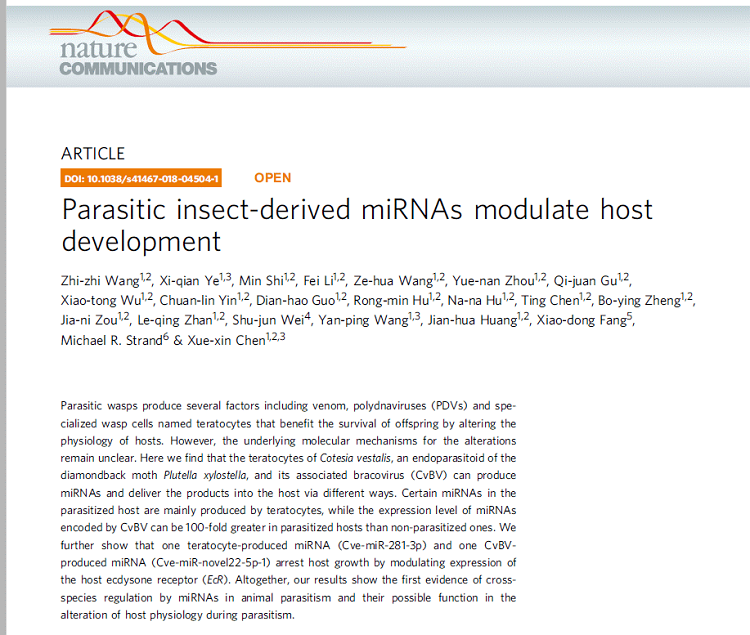Parasitic insects are a very large group of animals that live in or on the other arthropods. They have been also widely used in biological control of many economically important insect pests around the world. Parasitic insects, particularly parasitic wasps, produce several factors including venom, polydnaviruses (PDVs) and teratocytes that ensure the survival of wasp offspring by altering the physiology of hosts. Most known effector molecules produced by C. vestalis and other parasitic wasps are proteins. It is unknown whether parasitic animals such as insects produce miRNAs that affect hosts.
Zhejiang University researchers have discovered the first evidence of cross-species regulation by miRNAs in animal parasitism and their possible function in the alteration of host physiology. They report their findings June 7 in the journal Nature Communications.
Using snRNA sequencing technology, the research team, led by the senior author Dr. Xue-xin Chen, identified hundreds of miRNAs fromlarvae and teratocytes of Coteisa vestalis, an endoparasitoid of the diamondback moth Plutella xylostella. They discovered that its associated polydnavirus, i.e. bracovirus (CvBV), can produce miRNAs, which have no homologues in host and their expression levels in host can be hundredfold after post being parasitized. Further analysis showed parasitic wasp teratocytes could also express and secrete miRNAs into the host via a different way. Most teratocyte-derived miRNAs share homologues with those from host, and their abundance in host Pxem_cell line co-cultured with teratocytes and the parasitized host hemocytes are mainly from teratocytes and partly due to up-regulation of isoforms of host. Futhermore, the research team verified that two miRNAs (one teratocyte-derived and one PDV-derived miRNAs) target the host EcR gene, and injection of agomirs corresponding to these miRNAs cause delays in growth and metamorphosis of host larvae, indicating that parasitic insect miRNAs not only can manipulate but also may cooperate in a successive manner to alter the host development. Other miRNAs they identified may also have roles in regulating host metabolism and immune responses as target analyses showed.
Dr. Zhizhi Wang, PhD student Xiqian Ye, Dr. Min Shi, Dr. Fei Li, and PhD student Zehua Wang are co-lead authors. Other cooperators include Dr. Shu-jun Wei of Beijing Academy of Agriculture and Forestry Sciences, Dr. Xiao-dong Fang of BGI-Tech, China and Dr. Michael R. Strand of University of Georgia, USA. This work was supported by funds from the State Key Program of National Natural Science Foundation of China (Grant No. 31630060), the Chinese National Key Project for Basic Research (973 Project) (Grant No. 2013CB127600), and the National Science Fund for Innovative Research Groups (Grant No. 31321063).
Related Links: https://www.nature.com/articles/s41467-018-04504-1
